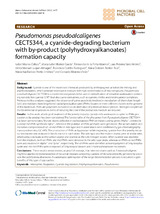Pseudomonas pseudoalcaligenes CECT5344, a cyanide‑degrading bacterium with by‑product (polyhydroxyalkanoates) formation capacity
Autor
Manso Cobos, Isabel
Ibáñez García, María Isabel
Peña Moreno, Fernando de la
Sáez Melero, Lara Paloma
Luque-Almagro, Víctor Manuel
Castillo Rodríguez, Francisco
Roldán Ruiz, María Dolores
Prieto Jiménez, María Auxiliadora
Moreno-Vivián, Conrado
Editor
BioMed CentralFecha
2015Materia
AlkalophileBioplastics
Cyanide degradation
Polyhydroxyalkanoates
Pseudomonas
METS:
Mostrar el registro METSPREMIS:
Mostrar el registro PREMISMetadatos
Mostrar el registro completo del ítemResumen
Background: Cyanide is one of the most toxic chemicals produced by anthropogenic activities like mining and
jewelry industries, which generate wastewater residues with high concentrations of this compound. Pseudomonas
pseudoalcaligenes CECT5344 is a model microorganism to be used in detoxification of industrial wastewaters containing
not only free cyanide (CN−) but also cyano-derivatives, such as cyanate, nitriles and metal-cyanide complexes.
Previous in silico analyses suggested the existence of genes putatively involved in metabolism of short chain length
(scl-) and medium chain length (mcl-) polyhydroxyalkanoates (PHAs) located in three different clusters in the genome
of this bacterium. PHAs are polyesters considered as an alternative of petroleum-based plastics. Strategies to optimize
the bioremediation process in terms of reducing the cost of the production medium are required.
Results: In this work, a biological treatment of the jewelry industry cyanide-rich wastewater coupled to PHAs production
as by-product has been considered. The functionality of the pha genes from P. pseudoalcaligenes CECT5344
has been demonstrated. Mutant strains defective in each proposed PHA synthases coding genes (Mpha−, deleted in
putative mcl-PHA synthases; Spha−, deleted in the putative scl-PHA synthase) were generated. The accumulation and
monomer composition of scl- or mcl-PHAs in wild type and mutant strains were confirmed by gas chromatographymass
spectrometry (GC–MS). The production of PHAs as by-product while degrading cyanide from the jewelry industry
wastewater was analyzed in batch reactor in each strain. The wild type and the mutant strains grew at similar rates
when using octanoate as the carbon source and cyanide as the sole nitrogen source. When cyanide was depleted
from the medium, both scl-PHAs and mcl-PHAs were detected in the wild-type strain, whereas scl-PHAs or mcl-PHAs
were accumulated in Mpha− and Spha−, respectively. The scl-PHAs were identified as homopolymers of 3-hydroxybutyrate
and the mcl-PHAs were composed of 3-hydroxyoctanoate and 3-hydroxyhexanoate monomers.
Conclusions: These results demonstrated, as proof of concept, that talented strains such as P. pseudoalcaligenes
might be applied in bioremediation of industrial residues containing cyanide, while concomitantly generate by-products
like polyhydroxyalkanoates. A customized optimization of the target bioremediation process is required to gain
benefits of this type of approaches.

